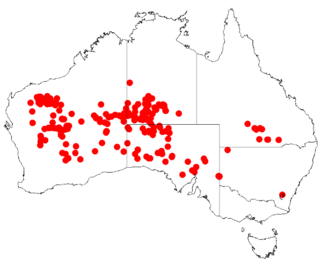
Acacia ayersiana is a plant that grows in arid areas of Australia.

Acacia applanata, also known as golden grass wattle or grass wattle, is a grasslike shrub belonging to the genus Acacia and subgenus Alatae. It is native to the south west of Western Australia.

Acacia caesaneura, commonly known as western blue mulga, is a shrub or tree belonging to the genus Acacia and the subgenus Juliflorae that is endemic to western Australia.

Acacia clelandii, also known as umbrella mulga, is a shrub belonging to the genus Acacia and the subgenus Juliflorae that is native to arid parts of central Australia.

Acacia conniana is a shrub belonging to the genus Acacia and the subgenus Juliflorae that is endemic to the southern coast of western Australia.

Acacia drepanophylla is a tree belonging to the genus Acacia and the subgenus Juliflorae that is endemic to western Australia

Acacia fuscaneura, commonly known as sooty wattle, is a tree belonging to the genus Acacia and the subgenus Juliflorae. It is native to arid areas of central Australia.

Acacia heteroneura is a shrub belonging to the genus Acacia and the subgenus Juliflorae that is endemic to western Australia.

Acacia minyura is a tree or shrub belonging to the genus Acacia and the subgenus Juliflorae endemic to arid parts of central Australia.

Acacia mulganeura, commonly known as milky mulga and hilltop mulga, is a tree or shrub belonging to the genus Acacia and the subgenus Juliflorae that is endemic to arid parts of central and western Australia.

Acacia paraneura, commonly known as weeping mulga, is a tree or shrub belonging to the genus Acacia and the subgenus Juliflorae. It is native to arid regions of Australia. The Indigenous Kurrama peoples know the tree as warlun.

Acacia ramulosa, commonly known as horse mulga or bowgada wattle, is a shrub belonging to the genus Acacia and the subgenus Juliflorae endemic to arid areas of Australia.

Acacia rhodophloia, commonly known as minni ritchi or western red mulga, is a tree or shrub belonging to the genus Acacia and the subgenus Juliflorae that is endemic to a large area of arid central western Australia. The Indigenous group the Kurrama peoples know the plant as mantaru.

Acacia sessilispica is a shrub belonging to the genus Acacia and the subgenus Juliflorae native to Western Australia.

Acacia tenuissima, commonly known as narrow-leaved wattle, broom wattle, minyana, slender mulga or slender wattle, is a shrub belonging to the genus Acacia and the subgenus Juliflorae endemic to temperate and tropical areas of Australia. Indigenous Australians the Kurrama peoples know the plant as Janangungu and the Banyjima know it as Murruthurru.

Acacia concolorans is a shrub belonging to the genus Acacia and the subgenus Phyllodineae that is endemic to Western Australia.

Acacia errabunda is a shrub belonging to the genus Acacia and the subgenus Phyllodineae native to Western Australia.

Acacia veronica, commonly known as Veronica's wattle, is a shrub or tree of the genus Acacia and the subgenus Plurinerves that is endemic to a small area of south western Australia.

Acacia vittata, commonly known as Lake Logue wattle, is a shrub of the genus Acacia and the subgenus Plurinerves that is endemic to a small area in western Australia.

Acacia disparrima, also commonly known as southern salwood, is a shrub or tree belonging to the genus Acacia and the subgenus Juliflorae that is native to north eastern Australia.




















